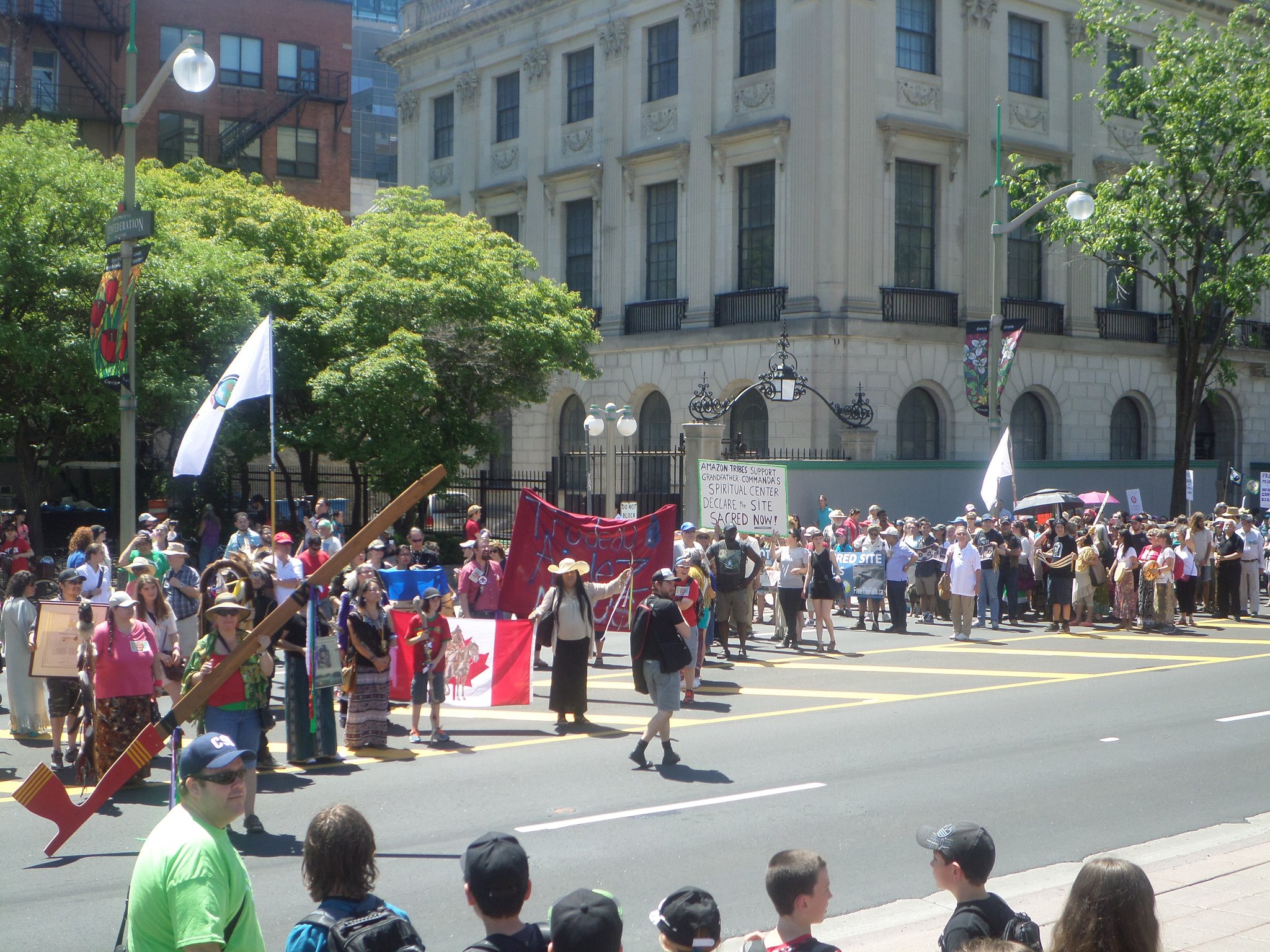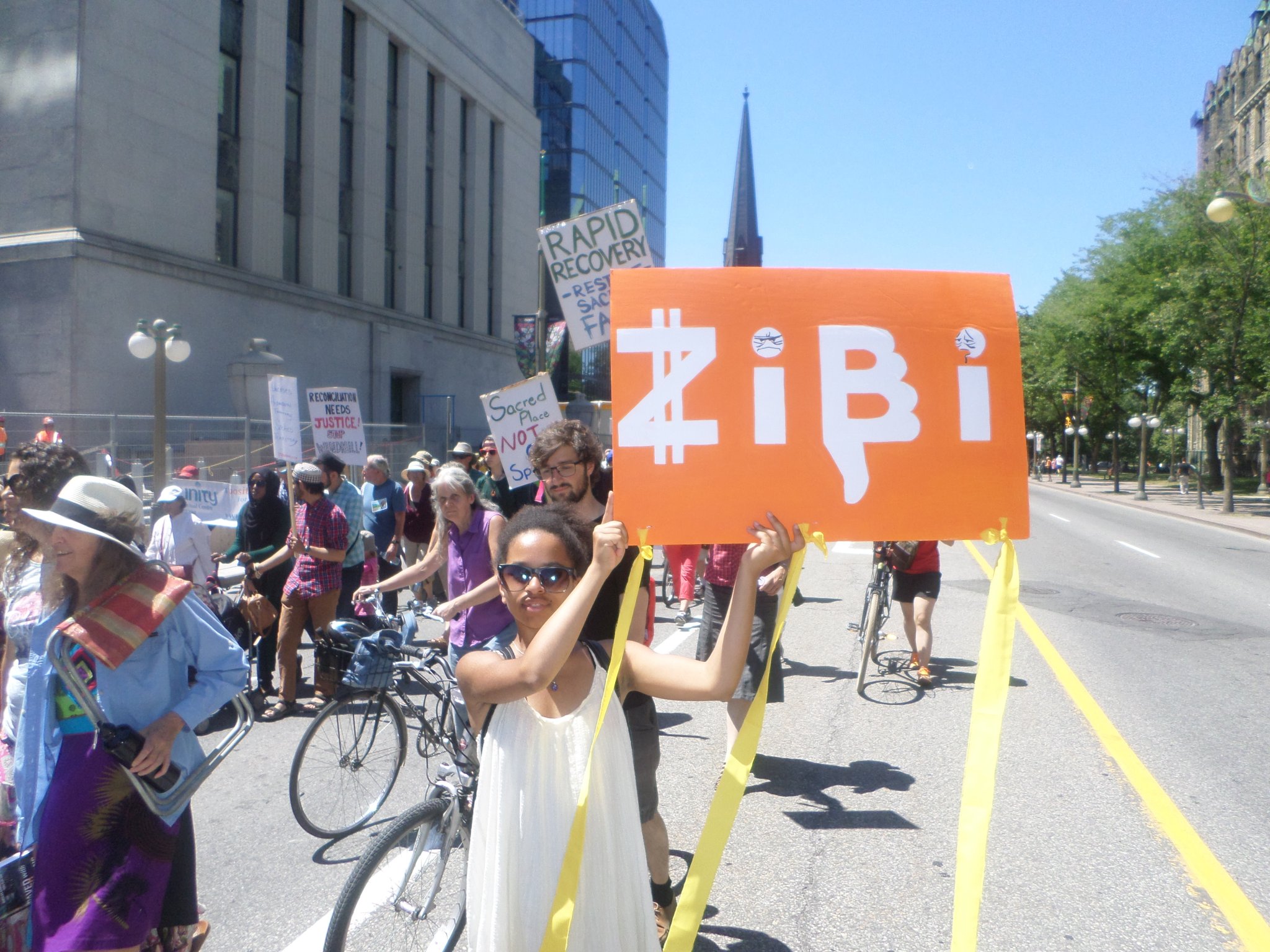Like this article? rabble is reader-supported journalism. Chip in to keep stories like these coming.
The fight to protect the sacred Chaudière Falls from a condominium development is gaining momentum following a massive sacred walk on Friday, June 17.
The sacred walk, which was initiated by Algonquin Elders from Pikwàkanagàn, brought out approximately 500 people on the Friday afternoon.
The day after the sacred march Stop Windmill, a group of non-native student and labour allies, called a rally for Monday, June 27.
The rally of 30 protesters marched from Minto Park to Environment and Climate Change Minister Catherine Mckenna’s office to deliver an open letter and demand the minister publicly support the consent of the Algonquin nation and stop any further steps by the National Capital Commission (NCC).
Cost of condos on a sacred site
The proposed Zibi condominiums would be built on the Chaudière and Albert Islands in McKenna’s consitutency. The islands and adjacent falls are a sacred site for Algonquin and Indigenous people and the area has never been ceded by the Algonquin Nation.
In January of 2015, the NCC approved the sale of the land to Windmill, a private developer and in October 2015, the City of Ottawa rezoned the site for commercial construction. Since then there has been an active campaign to protect the area, although efforts to restore the site to First Nations date back 40 years.
The Band Council of Pikwàkanagàn and the Algonquins of Ontario both support the condominium project, while the other nine Algonquin councils and the Assembly of First Nations of Quebec/Labrador oppose to it.
Albert Dumont, an Algonquin spiritual adviser who has been at the forefront of the campaign to protect the sacred site, said that he was at the June 17 sacred walk “to be part of this battle to stand up against people who would block our access to a sacred site.”
“It’s a birthright of a human being to take their place in a healing circle, and whenever they block us from accessing an ancient sacred site, that’s what they are in fact doing, is trampling on our right to freedom of religion,” Dumont said.
The sacred march left from Victoria Island and marched to Parliament Hill where the crowd listened to elders speak about the importance of protecting the falls.
Jane-Ann Chartrand, an Algonquin elder from Algonquin Park, spoke at Parliament Hill, “We’re here because of the next seven generations, of your people and my people, to join hands in unity….We need to unleash Chaudière. We must release the falls. We need to build the Peace Centre.”
The Peace and Healing Centre was the vision of the Elder William Commanda, now deceased. According to the document “Algonquin Elders’ Gathering to Develop a Vision for Victoria Island, March 27 – 28, 2002,” Elder Commanda worked with Firekeeper Peter Decontie to create the centre.
In 2002, five Algonquin communities, the First Nations Confederacy of Cultural Educational Centres and the Algonquin Anishnabeg Nation (representing the Algonquin of Abitibiwinni, Eagle Village, Kitcisdakik, Kitigan Zibi, Lac Simon and Long Point) supported the project.
McKenna delivers rhetoric before July 18 deadline
On June 27, protesters marched to McKenna’s office with an open letter and met with the minister.
“We are here today asking that you publicly state your support for the chiefs demands for respect, for an opportunity to consult and obtain their consent, the consent of the Algonquin nation in this process, and…asking that you intervene immediately to stop any further steps by the NCC to transfer this Algonquin land to private ownership,” said Kevin Skerrett, a member of Stop Windmill, to McKenna.
“We have signed on to UNDRIP, the UN Declaration on the Rights of Indigenous Peoples, and we have talked about the need to rebuild our relationship with our Indigenous Peoples, and we have a constitutional obligation to work and engage with Indigenous Peoples,” said McKenna.
After she spoke, Skerrett asked again, “Will you stop the sale and transfer of this land, yes or no?”
“We are going to work with the community to find a good outcome,” McKenna’s answered.
According to Lynn Gehl, an Algonquin scholar and activist, the minister “was putting out a lot of rhetoric…Domtar and the NCC and Windmill, they’re going to develop a sacred place, and that’s a terrible thing to be doing. In the context of reconciliation and nation-to-nation, you don’t develop an Algonquin sacred place.”
“We’ve been waiting 250 years. We’re sick and tired of your diversity of views, and we’re sick and tired of your discussion. We want you to stop the development of our land. We want our land back,” she concluded.
Organizers from Stop Windmill have given the minister until July 18 to respond to the Chiefs demands. If she has not responded by then, they will return to her office.
“If her response then is the same as today…we will be announcing our next steps and escalating the pressure on this government to do the right thing and intervene,” said Skerrett.
Matt Cicero was born in Ottawa, and lives there now. He is a ritual abuse survivor. He is a long-time activist, primarily as an Indigenous solidarity organizer, but also in anti-prison and anti-police movements. He is a writer with The Leveller, a student/community newspaper in Ottawa, as well writing his blog Stones and Sticks and Words. He also co-hosts the radio show OPIRG Roots Radio, a grassroots social justice news show.





